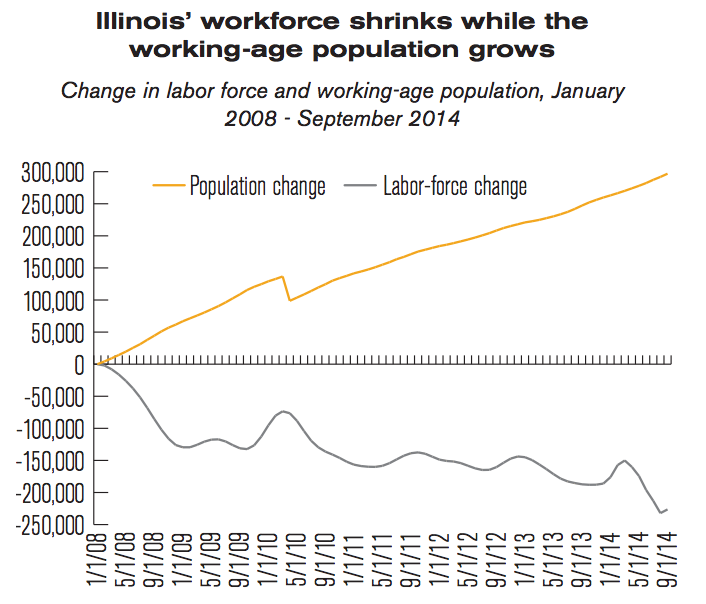Illinois’ true unemployment rate: 18.1 percent
The unemployment rate is a state’s most closely monitored indicator of economic health. The Illinois unemployment rate rose sharply through the Great Recession, and continues to fluctuate and trend downward as a result of both economic growth and a shrinking workforce. Illinois’ working-age adult population, from which the workforce is drawn, has grown by nearly...
The unemployment rate is a state’s most closely monitored indicator of economic health. The Illinois unemployment rate rose sharply through the Great Recession, and continues to fluctuate and trend downward as a result of both economic growth and a shrinking workforce.
Illinois’ working-age adult population, from which the workforce is drawn, has grown by nearly 300,000 since the start of the recession. Despite this growth in the working-age population, the Illinois workforce has shrunk by 226,000 over the same period. This leaves a gap of more than 500,000 working-age Illinoisans who either dropped out of the workforce or never entered it.
Thus, more than 500,000 Illinoisans are missing from the calculation of the state’s unemployment rate. To draw a more accurate indicator from employment data, it is necessary to address not only those who are currently unemployed, but also the missing 500,000 Illinoisans, along with those who are employed part time for economic reasons.
Indeed, Illinois state law sets precedent in accounting for people who have dropped out of the workforce when calculating unemployment. This precedent directs the analysis in this report. Alternative measures of unemployment show a more accurate picture of the true health of Illinois’ economic state. The alternative unemployment rate for Illinois, which includes long term unemployed workers and partially employed workers, is as high as 18.1 percent.
Workers dropping out of the workforce drives down the state’s unemployment rate. However, worker dropout is not a sign of a healthy state economy. On the contrary, a strong labor market would show a workforce growing in lockstep with the adult population, with marginally employed Illinoisans being lured to work by quality job opportunities. As it is, Illinois is on pace to recover from the Great Recession in September 2021, a full seven years from now. Such a slow recovery should give policymakers pause, especially in consideration of the fact that Illinois is regularly listed as one of the least competitive states in the U.S. for economic policy by both CEOs and small-business owners.
Click here to read the full report.
image credit: Suzanne Tucker / Shutterstock.com

